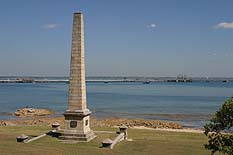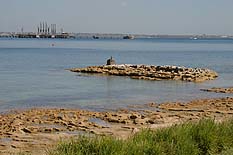
|
| The Captain Cook monument
|
Kurnell
Historic First Landing Site of Captain Cook and Governor
Phillip
Kurnell is a large peninsula that juts out from the mainland
between Botany Bay on the northern side and Port Hacking on
the southern side. Although it has not exactly been handled
with kid gloves, it is, in fact, a site of great historical
importance, as it was at Kurnell that both Captain Cook and
Governor Phillip first set foot on Australian soil, first
raised the flag of British territorial claim, and had their
first encounters with indigenous Australians and the
unfamiliar Australian bush. Today much of the peninsula is
reserved either for industry or national park and the only
habitation is at Kurnell itself, on the southern shore of
the Bay, where about 2000 people make their homes.
The neck of the Kurnell peninsula consists principally of
sand with a rocky headland at its eastern end. Thus,
although 100 hectares of land around Captain Cook's original
landing point were set aside in 1899, the peninsula has been
devastated by massive sandmining operations, as well as by
earlier clearing, grazing and hunting (koalas, now entirely
absent on the peninsula were once plentiful). Since the
1950s numerous large-scale polluting industrial operations
have sprung up on the peninsula. It has also been used for
landfill, sewage is discharged from the peninsula's
coastline, noxious weeds have spread alarmingly and
development is also posing a serious threat to the
peninsula's ecology. Fortunately, portions of land have been
reserved over the years and Botany Bay National Park,
covering the entire eastern headland, was declared in 1984,
protecting a number of interesting historic sites on the
headland (listed under Things to See). The bays between
Towra Point and Bonna Point (in the middle of the
peninsula's northern shore) were also declared a reserve in
1975. In fact, Towra Point was the Federal Government's
first declared Nature Reserve. It preserves Sydney's largest
extent of saltmarsh and mangroves, which has become an
important breeding, roosting and feeding site for
waterbirds, including a number of threatened species.
Given its obvious access to marine life, indigenous
Australians had long occupied the land at Kurnell prior to
Captain Cook's arrival. Archaeological evidence indicates
feasting on fish and shellfish on the peninsula, dating back
over 2000 years. The Gweagal tribe, a northern outpost of
the larger Dharawal group, inhabited the peninsula at the
time of British settlement. Owing to the abundance of
seafood they tended to inhabit the area on a more or less
permanent basis. They fished with barbed spears and fishing
lines with hooks made from shells and were guardians of
sacred white clay pits - the clay being used, variously, to
line the bottoms of canoes, for body painting, to make a
base for fires, and it was eaten as an antacid and a dietary
supplement, being rich in zinc. The word they attached to
the area was pronounced 'Cunnel'.
The first white man to visit the area was Captain James
Cook who had been sent to the South Seas with a dual
mission: to observe the transit of Venus across the sun and
to secretly investigate the largely uncharted southern
lands. He reached Botany Bay on April 28, 1770, whereupon he
and his party observed Aborigines onshore and others fishing
from canoes. As the Endeavour approached, about 10 of them
left their fireplace and sought higher ground to view the
ship. The British party anchored at Kurnell. Onshore was
what Joseph Banks described as 'a small village consisting
of about 6 or 8 houses.' An old woman gathered the children
together and the men landed their canoes on the beach. As
two small boats from the Endeavour approached, bearing Cook,
Banks and others, all retired to the bush except two men. As
language problems proved insuperable, Cook threw some nails
and beads ashore which, he says, 'they took up and seemed
not ill pleased'. He thought the men were signalling
encouragement to come ashore but, when he advanced, the men,
perhaps unsurprisingly, threw stones and 'darts' at them.
Cook fired a musket between the two in response. As it had
no effect, he then fired 'a second musket load with a small
shot', some of which struck one of the men, 'yet', he
observes, 'it had no effect than to make him lay hold of a
shield and defend himself.' Cook then continued to shore
where two more 'darts' were thrown. The two men left when a
third shot was fired and Isaac Smith, cousin of Cook's wife,
held the boat while Cook clambered ashore at Milgurrung
Beach, which has been described as the birthplace of modern
Australia.ı On the beach, Cook found '4 or 5 small children'
in one of the bark huts, to whom they gave some beads, some
'darts' and three bark canoes ('the worst I had ever seen'
wrote Cook), each made of a single piece of bark, 12 to 14
feet in length. Fish could be cooked on open fires which sat
on a base of clay inside these canoes. The only fresh water
about was in a 'small hole dug in the sand', presumably by
the Aborigines.
On the third day, Cook sent a party ashore to exploit
this underground stream. Another party went ashore to cut
wood and Cook made a landing at a place from whence some
other Aborigines had just fled, finding mussels broiling on
a fire and 'the largest oyster shells I had ever seen'
scattered about (overexploitation saw the complete
disappearance of these large mud oysters from the bay by
1900). Later, a group of '16 or 18...came boldly within 100
yards of our people. Mr Hicks tried to entice them to him
but all they seemed to want was for us to be gone.' Cook
wrote that they were 'well armed' although their weaponry,
he states, consisted of throwing sticks and their 'darts'.
The latter, he noted, 'have each four pointed prongs made
from fish bones and seem to be intended more for striking
fish than as offensive weapons.' They also caught 300 pounds
of fish 'in 3 or 4 hauls of the fishing net.'
The next day a seaman named Forby Sutherland died of
tuberculosis and his body was buried at the watering hole,
making him the first European to be buried in eastern
Australia. The southern point of the bay was named after him
and the approximate location of his grave was marked by the
Royal Australian Historical Society in 1923.
Later that day, Cook and others made an excursion inland
noting the condition of the land, sighting 'a small animal
something like a rabbit that ate grass' and finding huts,
trees that had been cut with a blunt instrument, barked
trees and steps cut into trees for climbing. At the watering
place '17 or 18 natives' attacked a Mr Gore. Cook and others
followed them but they 'could not be enticed to come near
us.' This pattern of assiduously attempting to make contact
with the locals continued for the rest of the stay at Botany
Bay but they continued a pattern of flight and attacks with
fishing darts. One can only speculate that musket shot was
not endearing as an opening salvo. Cook did attempt leaving
some beads at one campsite, where they tasted the roasting
mussels after the inhabitants had fled, and another party
found a very old man, a woman and two small children
('they...were quite naked') who were clearly terrified,
would not speak and refused to touch a dead bird the party
offered them. Cook named the inlet Botany Bay because of
'the great quantity of new plants'.

|
| The rocks where the first
European stepped ashore on eastern Australia
|
After catching some large stingrays (two together
weighing 600 pounds), Cook made some summary notes in his
journal, describing the bay as 'safe and large' with 'ample
fresh water and wood for fuel' on the southern shore. The
gum trees were described as 'large and straight and the wood
hard' and he noted shrubs and palms and mangroves at the
head of the bay. 'The country is woody, low and flat as far
inland as we could see and I believe the soil is generally
sandy.' He noted many beautiful birds and waterfowl, oysters
and mussels 'which I believe to be the natives' main food
supply'. Of the locals he wrote: 'The natives do not appear
to be numerous, and are scattered in small groups. They are
of average height, very dark brown in colour and have lank
dark hair. No sort of clothing or ornament is worn. Some had
white paint on their faces and bodies. We know little of
their customs.' With this, he weighed anchor and put to sea
again.
Elsewhere Cook wrote more philosophically of indigenous
Australians:
'They may appear to some to be the most wretched people
on Earth, but in reality they are far more happier than we
Europeans; being wholly unacquainted not only with the
superfluous but the necessary Conveniences so much sought
after in Europe, they are happier in not knowing them. They
live in a Tranquility which is not disturbıd by the
Inequality of Conditions. The Earth and Sea of their own
accord furnishes them with all things necessary for life,
they covet not Magnificent House, Household-stuff etc, they
live in a warm and fine climate and enjoy a very wholesome
Air, so that they have very little need of Clothing and this
they seem to be very sensible of, for many of whom we gave
Cloth etc to, left it carelessly upon the Sea beach and in
the woods as a thing they had no manner of use for. In short
they seem'd to set no Value upon anything of their own for
any one article we could offer them; this in my opinion
argues that they think themselves provided with all the
necessaries of life and that they have no superfluities.'
With Britain's defeat in the American War of
Independence, the UK government was looking for a new outlet
for its unwanted convicts and, between January 18 and 20,
1788, the First Fleet, under Governor Phillip, anchored off
Kurnell, with a view to establishing Australia's first penal
colony. However, lack of shelter from prevailing winds for
the ships, insufficient water and poor soil led him to seek
greener pastures. On January 24, 1788 two French ships were
sighted off Botany Bay. Phillip thus raised the British flag
on the south side of the bay, near Sutherland Point before
continuing on to Port Jackson.
The first landowner at Kurnell was Captain James Birnie,
a mercantile trader who established Alpha Farm in 1815. He
worked the farm, a dairy and market garden (the farm was
known for its fruit and vegetables) with the assistance of
convict labour and built a small cottage he named 'Curnell',
which he took to be the Aboriginal name for the area. In
1821 John Connell received further land at Kurnell and, in
1828, when Birnie was declared insane, Connell also bought
Burnie's land, building a new homestead (Alpha House) where
Birnie's cottage had stood. Connell's grandson cut much of
the large timber from Kurnell and Woolooware for the Sydney
market and, by 1838, most of the peninsula was in Connell's
hands. The government reserved land for fortifications from
Cape Solander southwards around to Boat Harbour.
Noted businessman and landowner Thomas Holt, a member of,
and the treasurer of, the first NSW Legislative Assembly,
purchased Connellıs land from Connell's grandson in 1861. He
employed convicts, Aborigines and runaway sailors on his
estate. Unfortunately, his determination to clear, cultivate
and profit from the peninsula's land led to further felling
of timber, the burning of scrub and the introduction of
grazing sheep then cattle, all of which destroyed much of
the vegetation that bound and covered the dune system,
creating an unstable mass of sand that rapidly began to
spread. Sadly, this undermining of the peninsula only
beckoned a worse fate for the open dunes proved attractive
to sandmining operations which commenced in the 1930s. By
the end of the 1990s, over 70 million tonnes of sand had
been carted away for usage in the construction industry,
depleting the dunes, which stood 60 metres high in Cook's
day, and further destroying the woodlands that once grew on
them. Today, just two major sand dunes remain. An estimated
1.5 million tonnes of sand are removed per annum leaving a
series of deep, water-filled ponds filled with demolition
waste from building sites around Sydney.
The township of Kurnell was established in the 1880s,
though it had long been something of a holiday spot, known
for its fishing and shooting and the annual celebrations of
Cook's landing, centring on a large obelisk erected on the
spot by Holt. Early dwellings tended to be shanties, fishing
shacks and holiday camps built of bush and scrap materials
on land leased to individuals by landowners. The first store
was established in 1918 and a school was built in the early
1920s, although the village of Kurnell was not officially
proclaimed until 1933.
The Depression-era of the late 1920s and 1930s saw the
emergence of more improvised housing in the area. It was at
this time that a series of cliff houses sprung along the
peninsula's eastern edge. Some became quite sophisticated
structures with the inhabitants paying fees and rates for
the right to their idyllic existence. Sadly but
unsurprisingly this came to an end when the Lands Department
changed its policy and ordered them to leave, although one
insistent hanger-on did not vacate until someone set light
to a stolen car and pushed it over the cliff whereupon it
happened to plunge into, and destroy, his home.
Over the years income has been extracted from the
peninsula by a number of small-scale industries, such as
kelp gathering (filling a hole in the market created by
Japan's inability to supply world markets in the Second
World War), shell gathering (burned to produce lime),
shellgrit (for the pet bird and poultry industries), worms
for bait, and, most profitably, oyster cultivation and
fishing. The northern side of Botany Bay saw the development
of the first commercial fishing village in Australia in the
late 1820s although fishing shacks dotted many points on the
southern side by the 1850s. Salted catches were sent to the
Sydney markets. However, overfishing saw the numbers of
professional fishermen working the bay decline in the early
20th century. Matters improved considerably from the 1940s
but stocks are again in poor shape today and there are plans
to buy out professional anglers working the Bay and develop
fish-breeding programs. Australia's only marine fish farm
also exists at Kurnell.
Captain Cook Drive, from Caringbah to Kurnell, was
constructed in 1953 in conjunction with the establishment of
the enormous Australian Oil Refinery, with its shipping
berths and kilometre-long wharf, at Kurnell. It attracted
further large-scale industries to Kurnell, including a new
port, airport runways, a container terminal and chemical
storage facility on the northern side of the bay. This
development led to extensive dredging to deepen the bay and
provide material for shore expansion. However, the impact of
the dredging was severe, altering wave patterns which caused
extensive shore erosion, necessitating the reconstruction of
half the bay's shoreline. At Kurnell, in addition to the oil
refinery and the sandmining, other industries have emerged
such as a brick works, a chemical and pharmaceutical plant,
a tip for non-putrescible waste materials, carbon black
plants, a sewage treatment works and smaller industries such
as electrical engineering, a concrete products plant,
steel-fabrication, automotive repairs, plastics manufacture
and refrigeration. Further industrial and residential
developments are currently under consideration, including
expansion of sandmining operations. Consequently there is a
push on to attain a heritage listing for Kurnell to attempt
to preserve some of its features and its endangered species.

Broadwalk
Business Brokers
Broadwalk Business
Brokers specialise in General Businesses for Sale, Caravan Parks for
Sale, Motels for Sale, Management Rights & Resorts for Sale, Farms for
Sale, Hotels for sale,Commercial & Industrial Properties for Sale.
Phone:
1300 136 559
Email:
enquiries@broadwalkbusinessbrokers.com.au
AUSTRALIAN BUSINESSES FOR SALE
COFFS HARBOUR BUSINESS BROKERS
BROADWALK BUSINESS BROKERS
GOLD COAST BUSINESSES FOR SALE
BRISBANE BUSINESSES FOR SALE
SYDNEY BUSINESSES FOR SALE
CARAVAN PARKS FOR SALE
BUSINESSES FOR SALE
MOTELS
FOR SALE
HOTELS
FOR SALE
Disclaimer
We advise prospective purchasers that we take no
responsibility for the accuracy of any information in the business
provided by vendors or their professional advisers and that they should
make their own enquiries as to the accuracy of this information,
including obtaining independent legal and/or accounting advice
Kurnell

